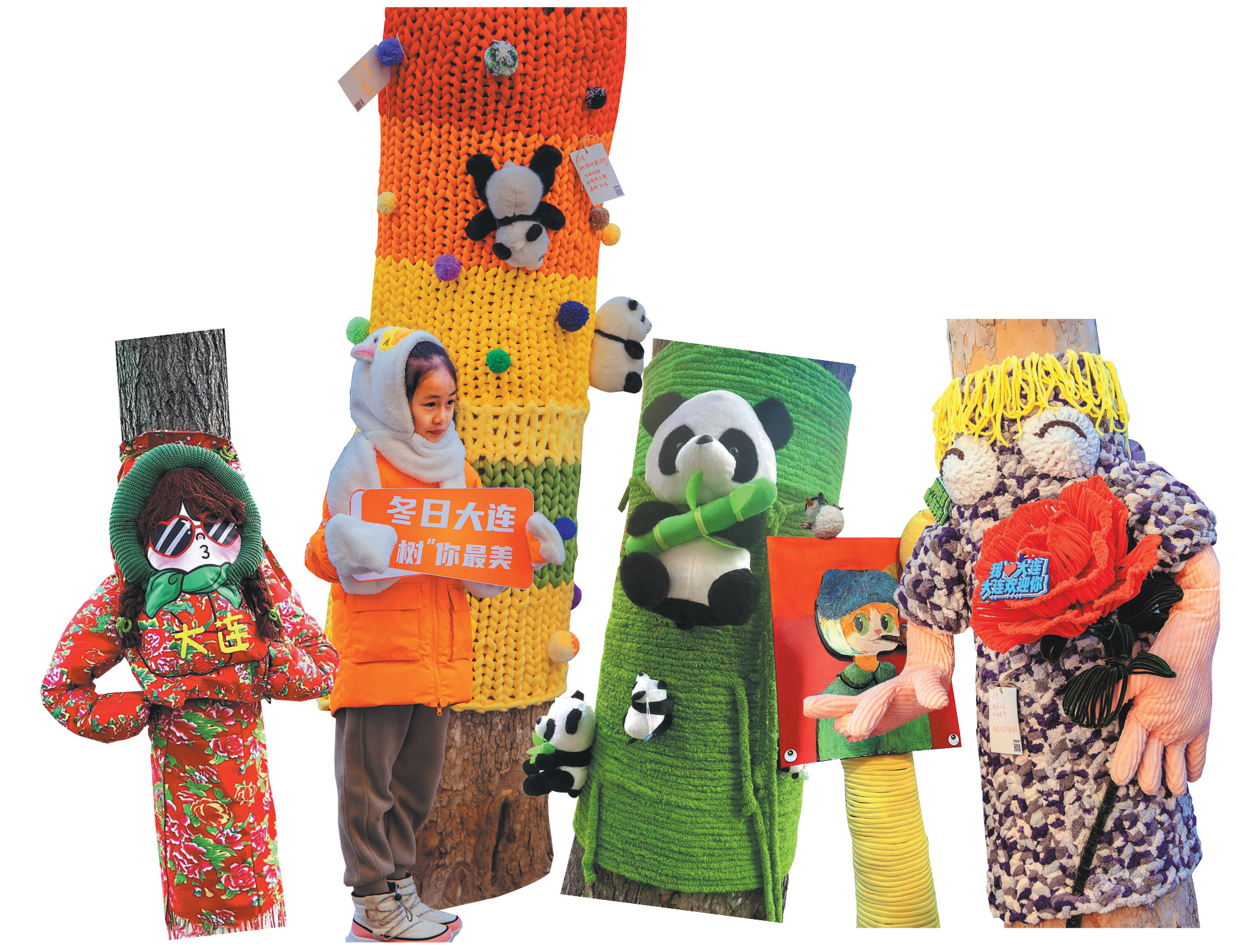Decoration trend brings pride, sense of community

From online to offline, a trend of dressing trees in colorful sweaters has swept across the country this winter, with the vibrant spectacle adorning roadsides in many places.
Initially, people used AI software to "dress" iconic buildings such as the Temple of Heaven in Beijing and the Oriental Pearl Tower in Shanghai with the sweaters. Tourism departments then joined in, dressing historical buildings and landmarks.
In Dalian, Liaoning province, several popular attractions in Zhongshan district saw roadside trees adorned with colorful sweaters, each with its own theme reflecting the creativity of the weavers.
One that gained widespread attention in the northeastern port city was a ginkgo tree in front of the post office at Zhongshan Square, decked out in a sweater of bright colors intended to trigger the release of dopamine, and with a heart-shaped pattern.
"To respond to the tourism department's 'Winter Fairy Tale, Romantic Dalian' theme event, we thought of dressing the tree with a sweater, aiming to make it a picturesque spot for photos," said Meng Zhuo, the head of the Zhongshan branch of China Post.
READ MORE: Suburban village rekindles passion for leisurely shopping
In late November, resident Miao Chunyan, 63, was invited to knit a sweater for the ginkgo tree. She enjoys knitting dolls, hats and other small items, but had never thought of knitting a large sweater for a tree.
"There are many elements to consider, such as knitting size, density and more," Miao said. She made multiple trips between her home and the post office, measuring, modifying and fitting the sweater for size repeatedly.
When the garment decoration was finished, the tree attracted many visitors who eagerly shared their beautiful photos on social media.
The postal company added sweaters to a mailbox and lamp post near the tree.
While knitting the mailbox sweater, Miao carefully measured its irregular top section, pondering how to knit the pullover to be both aesthetically pleasing and durable.
"One night, I couldn't sleep and thought about how the arm part of the sweater I knitted during the day was too loose. It could easily get stretched if someone pulled it for a photo," she recalled.
It was midnight, but she immediately got up, unraveled the arm part, and reknitted it tighter. "That way, it wouldn't easily stretch, and it would also be easier to maintain," said Miao.
Enthusiastic participation
After that, the Dalian Women's Federation launched a program to dress trees, which attracted families and individuals.
People took matters into their own hands by dressing the trees along Nanshan Road and Qiqi Street in so-called dopamine sweaters. Many schools and businesses spontaneously knitted sweaters for trees on campuses, and outside their premises.
The sweater styles kept evolving. Some trees were fitted with miniskirts, some with cute dolls attached to the sweaters, and others had paper tags filled with New Year blessings.
"We planned this activity to leverage the federation's expertise in family work and also to contribute to Dalian's winter tourism, creating new hot spots for social media check-ins," said Chen Jing, vice-chairperson of the Dalian Women's Federation.
The two streets selected are located in a well-known cultural community that attracts many young entrepreneurs. The trees dressed in dopamine sweaters blended harmoniously with the streets' atmosphere.
"We initially planned to decorate 100 trees, but the enthusiasm of applicants far exceeded expectations, so we added 20 more. Once applications were opened on Dec 29, they were quickly fully subscribed," she said.
"Although the volunteers' skills varied, with some knitting, some wrapping, and others meticulously and professionally designing, each tree's sweater displayed unique creativity, reflecting residents' love for the city," Chen added.
Many people contacted the federation, expressing their desire to decorate trees, leading to the launch of a second group of 50 trees.
Chen said that before launching the activity, they conducted relevant research, coordinated with the gardening and municipal departments, and consulted experts.
"Dressing the trees in sweaters for a short period would not have any negative impact," she said they concluded.
The sweaters started to be removed after Lantern Festival, which fell on Wednesday.
The federation also set up a dedicated working group to repair mishaps, with two staff members patrolling the streets daily, carrying scissors, needles and yarn. If any sweaters were found to be unraveling or coming loose, they were promptly repaired, Chen said.

Family involvement
Volunteers Zhao Shuang and her 10-year-old daughter Shi Yunxin participated twice in the program and "adopted" two trees.
For their first tree, they used deep blue color for the sweater to symbolize the power of the sea, and added a pair of orange hands to evoke a feeling of warmth and an embrace.
For the second tree, in addition to the festive sweater, they made a large bouquet of roses using twist rods. They placed them in a heart-shaped bag, and included inspirational cards offering encouragement to those who see it.
"When the first batch of (tree) adoptions was almost full, I was lucky to secure a spot. During the second batch, I involved my group of friends to take responsibility for 50 trees," Zhao said.
Since 2017, the mother and daughter have been participating in various federation activities. They have made like-minded friends and formed a volunteer service team.
"The enthusiasm of everyone was particularly high. Initially, we planned for one family to adopt one tree, but there were too many people interested. In the end, some trees had two or three, or five or six families adopting them together," she said.
The Picture Book Dalian volunteer team also participated in the tree dressing.
Wang Xuehong, head of the team, said that as soon as they noticed the activity posted on the federation's WeChat account, they immediately claimed 20 trees.
"Mostly parents brought their children to participate. We collected many old sweaters and even found some discarded sweater pieces from a sweater factory. Everyone worked together to sew, creating various styles of tree coats," said Wang.
The children were actively involved. Some of them would occasionally check on the trees they helped decorate, and feel a sense of responsibility and pride, which was particularly meaningful to them, she said.
Controversy, reflection
While dressing trees in sweaters has garnered a lot of praise around the country, it has also sparked controversy.
Professor Liu Yong, from Beijing Forestry University, told Beijing News that trees like the locust and the camphor, which have been planted for many years, have already adapted to the local climate and do not require additional warmth. Dressing them in sweaters is more like a form of "performance art".
"During the holiday season, dressing them for a couple of days to create an atmosphere is feasible, but doing so for an extended period could lead to insects laying eggs inside, causing diseases in the trees," he said, adding that there have been instances of ancient trees wrapped in banners for many years, and upon removal, insect eggs were found.
Some netizens wondered if such activities were a waste of resources and suggested prioritizing people's needs. Others felt the practice was a form of formalism.
"This may be a manifestation of the lack of innovative thinking in urban greening management. Blindly dressing trees in 'clothes' may affect the health of the trees, such as causing poor ventilation and breeding mold," one netizen commented on social media platform Xiaohongshu.
But many other netizens said that seeing the trees dressed in sweaters had lifted their spirits and made them feel that their city is more vibrant and lovable.
From plush toys to city buildings, many young people are keen on anthropomorphizing objects and imbuing them with personality and emotion.
Some enthusiasts believe this is a way of presenting existing objects in a fresh manner and adding novelty to them. However, critics worry that treating society as a fairy tale reflects a reluctance to grow up and is indicative of a "Peter Pan syndrome".
Feng Lei, a specialist from the Dalian Psychological Society with a doctorate in applied psychology, is positive about the effects of the trend.
"People are happy when they are helping others," she said. "When dressing trees in sweaters and making them warm and cute, it's actually about bringing warmth to oneself. Many people hugging the trees in sweaters are also warming themselves," Feng said.
ALSO READ: Anthems weave together a collective soul
She believes that dressing trees in sweaters is a novel and creative idea, and a way for people to enthusiastically express their love for their city.
Behind the popularity of this activity is a collective unconscious need for warmth from others, especially during challenging times, and a psychological need to be cared for and comforted, experts said.
Researcher Cao Yixia from the Institute of Applied Economics of the Shanghai Academy of Social Sciences told Shanghai Observer news portal that young people's fondness for personifying everything is a projection of a desire for companionship. This is done in the context of a relative lack of social interactions and contact with neighbors, Cao said.
An attending physician in the field of mental health told Shanghai Observer that such phenomena are all rooted in psychology.
"What people find fun is that it uses a contrast, turning buildings into people, turning things without warmth into warm things," he said.
In his view, this is just "a little game" that may not be popular after a while when new trends have soon emerged. In fact, turning city buildings into ice sculptures was popular on social media when the "sweater dressing" trend was still gaining popularity, he said.


